Sometimes to unwind and feel like I can be in control of my personal life circumstances I like to shut off the internet learn as much as I can about growing, harvesting, preserving or preparing food. Our land in Thailand gives us plenty of opportunities in this direction we have three jackfruit trees, two starfruit trees, six banana, two papaya and one coconut, along with three other trees that produce edible fruits once per year but which have no name in English. That’s not a bad haul on one rai (maybe 1/3 acre). Gardening is tough with the chickens, however.
Fruit trees are only good if you do something with the fruit. I’ve known many people in the United States who bought a house because they were enchanted with it having some sort of well established edible fruit on the property, whether it was apple, mulberry or plum, only to discover that fruit trees are a pain in the ass. The trees drop their bounty everywhere, littering the ground. Often the fruit is decayed by the point where it hits the dirt, and even if not, it is seldom pretty and without blemishes like the fruit sold in stores. Often you have to harvest beforehand by climbing the tree and you have to sort and cut out bad spots. Many trees produce all at once, dropping a bolus that will go bad quickly unless some type of preservation technique is employed (hint: alcohol production would be an in demand skillset in the post apocalypse, even, and probably even more so, if you don’t drink). I’ve known 2 or 3 people who ended up cutting down a very established, large and productive fruit tree because it was too much hassle.
Yesterday I messaged with expat BlueSphynx regarding writing about growing practices in Thailand specifically. I decided to ponder it as I cut into this 20 pound jackfruit from a few days ago, a process that took me four hours. I ended up using it for four things: a lot of the remnants became chicken feed, the surprisingly sweet inside fruit was sorted into my five liter brewing jug, some of the less ripe strands became vegetarian larb, and my last recipe is so addictively good I’m going to keep it top secret for now.
I say that because 8 months ago I published a simple cookbook called 21 Things to Do With Jackfruit. I offered it for free on KDP Select for awhile. I had almost no page reads and almost no royalties, which is the same as most of my work. At the time I had modified some existing jackfruit recipes and had also come up with some on my own. At the time there were absolutely zero google search results for two of my recipes I checked: jackfruit larb and jackfruit seed banana bread. Now there are a half dozen for each of those terms (but no link to my book which contains them), so I think people read my recipes and made their own modifications on the idea. I’m happy about that jackfruit is pretty hot in the vegan/vegetarian cooking space as a meat substitute, and these folks are often looking for new ideas. I just wish there was an easy way to track back and attribute.
I know censorship is a real thing in search algos a fair amount of my work has been blacklisted (i.e. my Covidvaccinecures website doesn’t even exist on google) or brownlisted (i.e. my two completely original cookbook recipes don’t show up in search even though I know I was the first with them, shares of my writing on facebook get maybe 1-2 likes and no page views with two people who enjoy my writing saying they didn’t even see the posts, my uncle couldn’t find my book on Amazon when searching by author name AND title). Amy Sukwan is good though: I’m the only person with that name and I’m nowhere near popular enough to need discrediting from factcheckers (it would be such an honor!).
I think we need to move away from the alarmists and towards the optimists, though both have an incredible and valued place in this fight. I plan on writing my next post about it.
This is a post I wrote about harvesting cashew nuts, which theThaiger did not pick up, I think because I was known to be a dreaded “anti-vaxxer” by that point. My guess is a lot of people living in Thailand (especially non-Thais) know very little about these harvesting practices and I’d love to share what I know.
Preparing Cashew Nuts
Note: Cashew nuts are in the poison ivy family, and should be handled with care. If you are worried, wear gloves or avoid handling the raw fruit and seed. Or you could be like me, and not even realize that there was a danger until you’d been eating them for years.
If you have gone to local food markets in Phuket late in the dry season around March or so, you might have noticed a strange yellow, orange or red fruit with a bulbous grey end sold in bags. If you’re interested in native foods like I am, you might have even purchased a bag of this strange looking fruit. The ones red in color are ripe and very juicy. They are sweet on the inside and more bitter and chalky around the also edible, but very soft and perishable skin. After dripping juice everywhere, you might have thrown the grey, seemingly inedible bulbous top into a trash bin.
Fresh Harvested Cashew Fruit
If you are like me, and have Thai friends or family members, they might have arched their eyebrows in surprise at seeing you throw that top, or rather bottom, part into the trash. It turns out that bulb contains the best known food to come from the cashew tree, that being the nut inside it. But to get to the cashew nut inside, you are going to have to burn the outside. Chestnuts roasting on an open fire, anyone?
Raw Cashew Bulbs Sold at Market in Phuket
The layer of skin surrounding the cashew nut contains a toxin found in poison ivy, so it needs to be processed before you can eat it. All members of this family from poison ivy to pistachios contain uroshiol, an oily substance which can cause rashes and itching. If you have a bad reaction to these substances, you might not want to handle the fruit either, or at least wear gloves. I’ve never personally had a problem. Cashew nuts aren’t nuts in a true sense, as they are surrounded by a fibrous bulb rather than encased in a hard shell. That outside needs to be burned off on a high heat open fire.
To do this place the bulbous greyish brown tops into a dedicated pan or wok, one that you don’t mind getting burnt black on the inside. Make sure that the pan is clean or has been burnt in before. Do NOT put any oil or seasoning into the pan, as you are trying to burn off the urushiol, and won’t be eating the outside anyways. Start a fire directly in the pan. The higher the flames, the better, but try to stay downwind of the smoke, as even that can bother some people.
Burning the Cashew Oil Off
I’ve found from past experience that if the heat level is too low or the fire is not direct, you burn the nut inside before you burn off all of the itchy oil. If this happens, your cashew nuts will crumble and flake when you try to get them out of the shell, or even worse, they’ll be as black and charred as the bulb is. I use crumpled newspaper inside the pan, adding more when the flames die down in size.
The Burnt Cashew Bulbs Should Have No Oily Sheen
The outside bulb is sufficiently cooked when it is charred solid black and no longer has any oily sheen. Once these black bulbs are cooled down, use a mallet or pokpok to open the shell. If you are not wearing gloves you will get your fingers dirty and charcoal black doing this. But if you’ve done things correctly, when you peel back the charred bulb, you will find a softish tan seed in the middle with a thin brown shell. That is the cashew nut.
These Cashew Nuts Got Eaten Too Fast to Take a Pretty Food Picture
Happy harvesting!
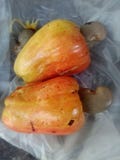


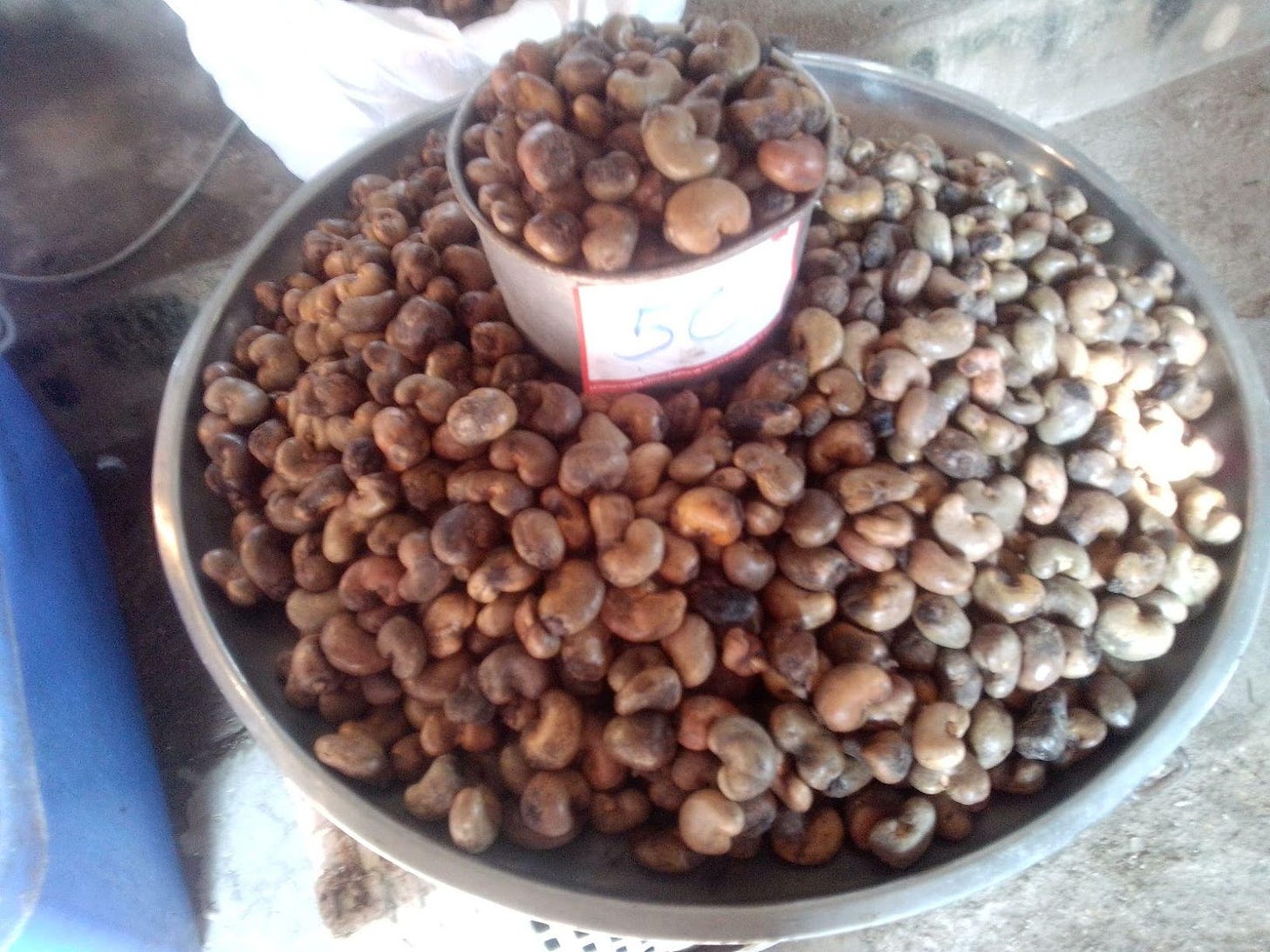
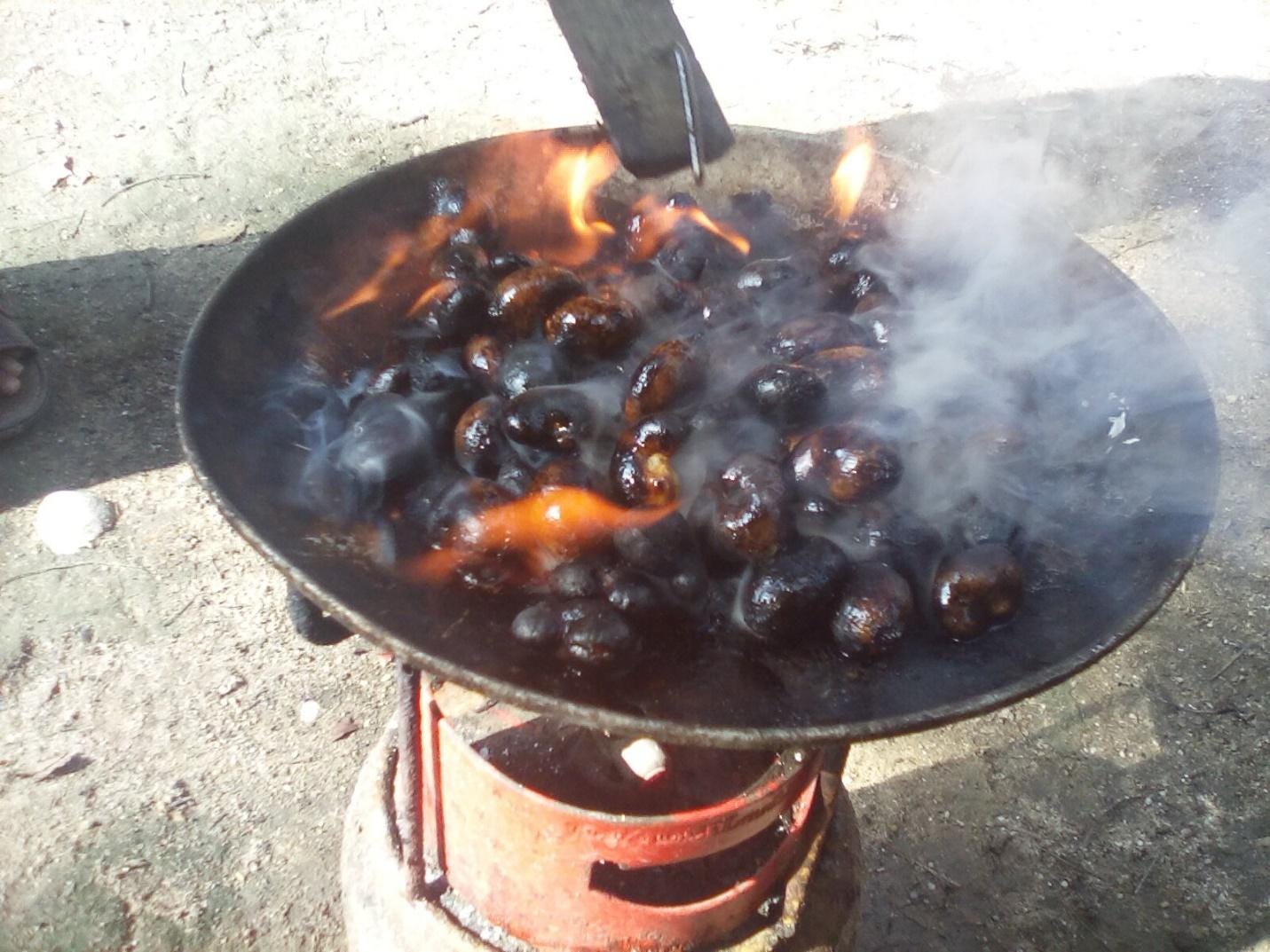
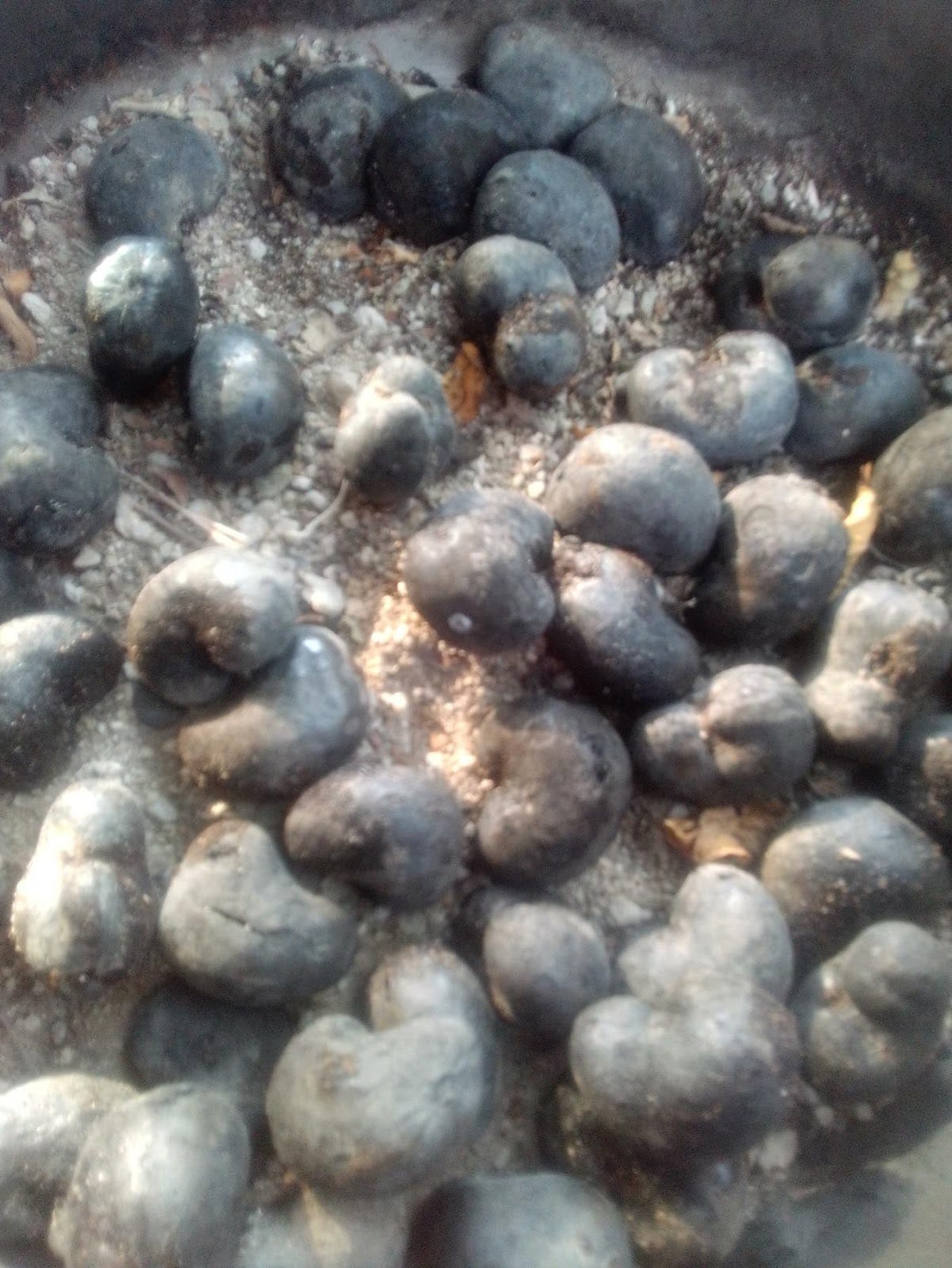
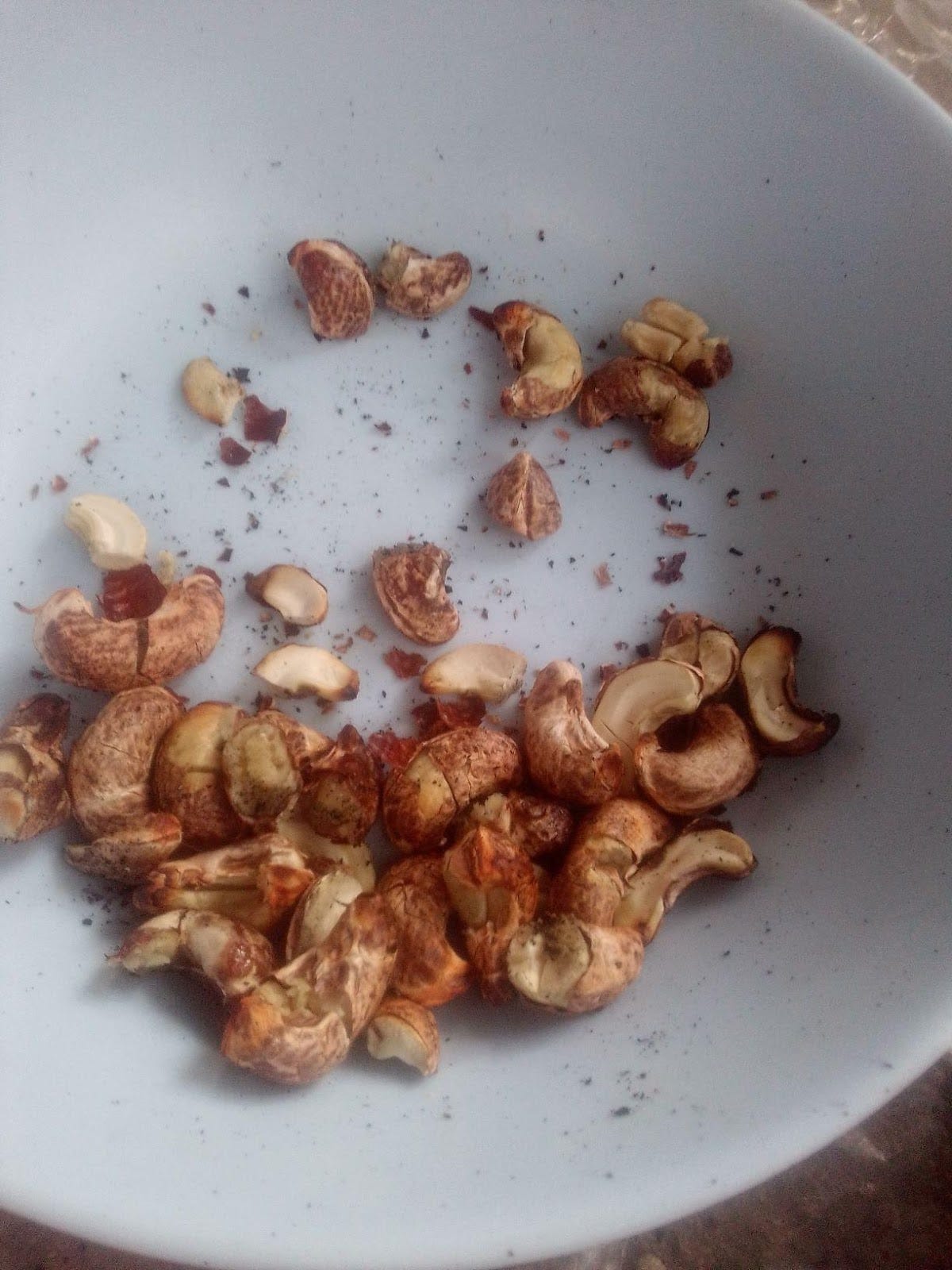
You rock, seeing real food harvested at home is so important. Lots of rotting fruit is why I became a brewer a few years ago, it made me sad to see all that bounty go to waste. Free booze on trees I call it. Currently have a sage rye beer, a coriander corn beer and a fir tip sassafrass beer. Rice wine next, I think ginger rice wine, but I try to stick to things I can gather so I get out in nature. Otherwise I just click and click. Best
"21 Things to Do With Jackfruit"
- holy moly, I always just ate them!
:-D Kidding aside, I only know the dried form that one can buy here... Fresh is more a rare sight, and perhaps a bit expensive to do anything big with.
As for Cashews: Do you have any idea how those who claim to sell rawfood cashews open them?
One can buy explicitly roasted ones here, and it's clearly visible in their darker color, and then they sell the regular supposedly "natural" ones which are not roasted through, but you can see, looking at a half one, the closer to the outer part, the more it looks changed and darker, with some brown spots here and there even on the outside. So I guess that's from the heat opening them.
But then some more rare makers sell e.g. cashew paste that's supposedly rawfood i.e. not heat treated at all, and it does seem to have a lighter color than cashew paste not sold with that claim. It also tastes a bit sweeter.
For some reason, my belly doesn't like me eating 100g or so roasted+salted ones (don't particularly like the taste either), but I can eat a lot of the claimed raw stuff. Taking a piece of 100% cocoa chocolate and dipping that in the raw cashew paste, glass from the refrigerator (getting solid-ish after some days)... that's one of the tastiest combinations on earth, to me anyway :D